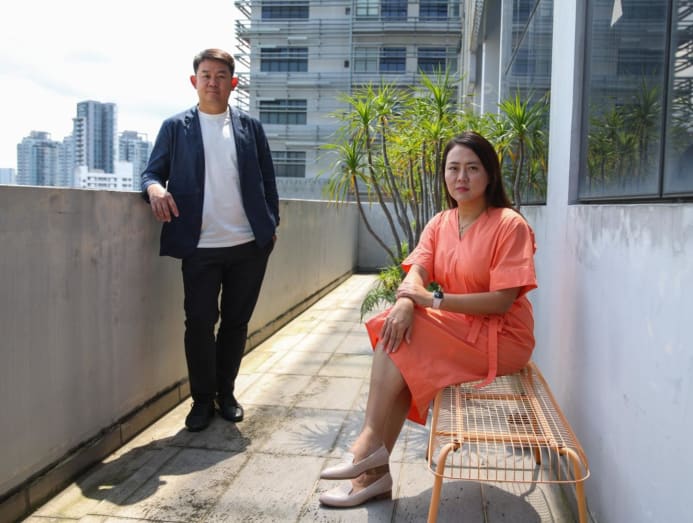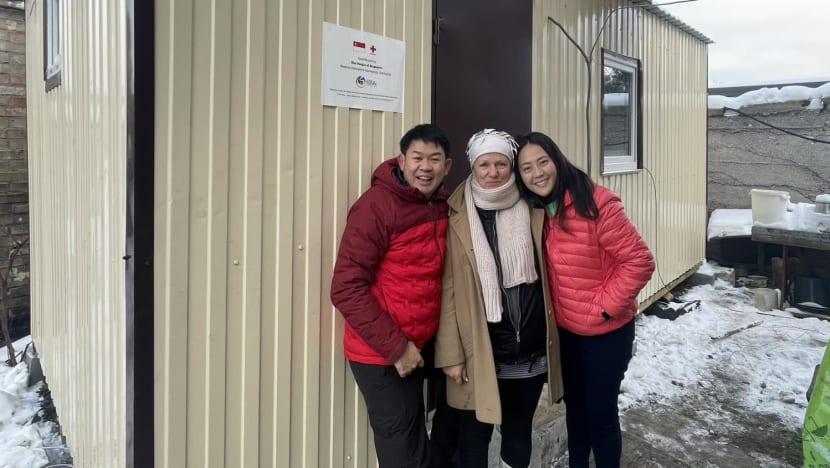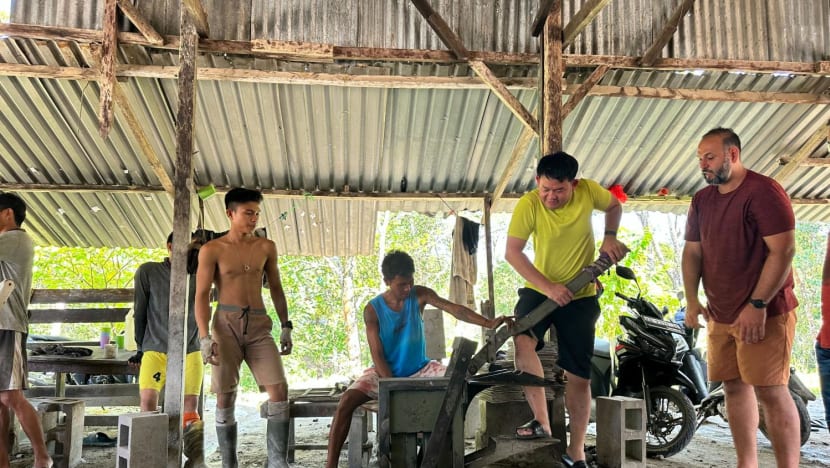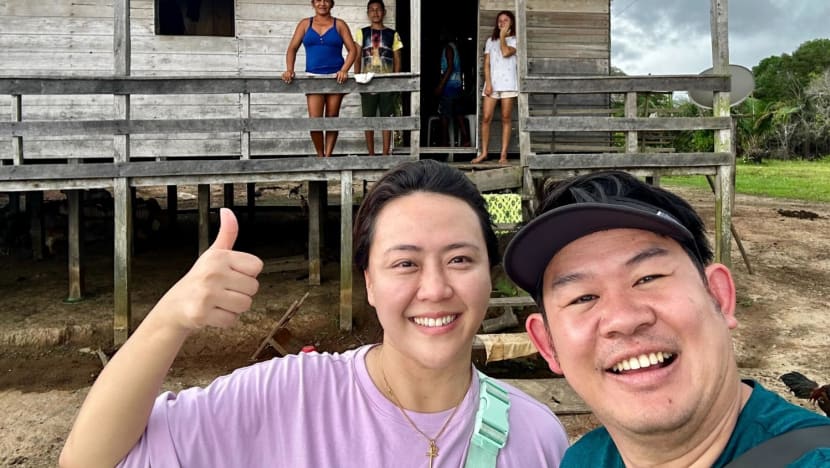The Stories Behind: The S'pore couple given residency by Ukraine after designing, building 500 emergency homes there
SINGAPORE — When Ms Lam Bao Yan flew to a refugee camp in eastern Germany in April 2022 to offer volunteer support to Ukrainians fleeing Russia’s invasion of their country, she could hardly have imagined what lay ahead.
Since then, Ms Lam, 40, along with her husband Rudy Taslim, also 40, have shuttled between Ukraine and Singapore around 10 times. The couple were also granted residential status in Ukraine after being invited to do so.
In that initial solo visit, Ms Lam lived at the refugee camp in Bad Blankenberg, Germany for a month, where she cooked for, counselled and cared for Ukrainian refugees.
“When the month was up, we were supposed to come back to Singapore, but I just felt like I could do more,” Ms Lam told TODAY.
“If these refugees were already so in need, I was wondering where is the need the most? I can only imagine it would be in Ukraine.”
This prompted her to enter Ukraine itself to continue serving its citizens and residents on the frontlines of the war. Her husband joined her in June 2022.
The couple are the founders of architecture firm Genesis Architects in Singapore, whose projects have included a resort in the Maldives, a residential development in Australia and various projects in Singapore.
The success of the business helps to fund their humanitarian work in Ukraine, as well as other good works around the world, including helping vulnerable children in the Amazon basin in Brazil.
In Ukraine, they have built more than 500 emergency houses for vulnerable members of the community, including the elderly, the young and the physically disabled.
The homes are in various parts of the country, including villages near the cities of Lyman, Slavyansk and Kramatorsk, which are all in the country's east.
Other emergency homes have been built in villages such as Moschun, outside the capital Kyiv.
The projects also provide employment to Ukrainian locals, whom they hire to help build these houses.
The couple are co-founders of humanitarian organisation Love on Ukraine.
Besides building homes for vulnerable Ukrainians, they also bring in generators from the Netherlands, and provide free electricity and internet access to individuals and organisations such as hospitals and orphanages.
This allows those in need to charge their mobile and medical devices, communicate with family members outside of Ukraine, and obtain information online on getting food and medical aid, if needed.
To date, they have planted more than 80 “lighthouses” – the name they give to these areas of refuge – in several locations across Ukraine.
Through Love on Ukraine, the couple also extend financial and social support to pregnant women who have lost their husbands to the war, and individuals with special needs or disabilities who are unable to leave the country.
The couple, who shuttle between Singapore and Ukraine every 10 weeks or so, were awarded Ukrainian residential status by the government in 2022.
Mr Taslim told TODAY that the Ukraine government recognised their commitment to rebuilding the country, and the couple were invited to apply for residential status. They were granted residency, which allowed them to continue their works in Ukraine.
They will next return to Ukraine on June 13, where they will focus on setting up rehabilitation hospitals for wounded casualties, and train chaplains and community leaders involved in trauma counselling.
They will also convert more vehicles in order to make them suitable for transporting casualties, and expand existing orphanages’ capacities.
Before each trip back to Ukraine, the couple prepare themselves by spending time with their families.
They also wean themselves off coffee, sugar and chocolate, and cut down their daily intake by one meal to ensure they can keep functioning even without easy access to food.
The pair also obtain medication to regulate heart palpitations, which they experience at times while serving on the frontlines of the war zone.

HEART WORK
Ms Lam and Mr Taslim are no strangers to such work – with Love on Ukraine being just the latest in a string of humanitarian projects they are involved in.
In 2013, the couple, who are Christians, attended Iris Harvest School, an evangelistic missions training school, in Mozambique.
Ms Lam said: “Twelve years ago, after building many big malls and buildings and infrastructure, we asked ourselves: Could there be more to architecture than all these big buildings?”
They decided to buy a one-way ticket to Mozambique to be trained as missionaries.
It was also on that trip that the couple learnt how their specific skill sets could play a part in designing and building a local university, to create educational opportunities for the next generation, said Mr Taslim.
Armed with a heart for mission work and equipped with vocational skills in architecture and entrepreneurial work, the pair sought to use their skill sets to practically meet different communities’ needs.
For example, Mr Taslim’s architectural training has helped him to quickly identify basic amenities to be built into the emergency homes in Ukraine, to ensure they are “fit for purpose” and able to “withstand for a good number of years”.
“Even after the war ends, people will still need to pick up their lives, to save money, before they can start building their homes again.
“These houses are permanent and can last them till then. And even if they were to build a house after that, they can consider our homes as an extension of their final home.”


OTHER PROJECTS AROUND THE GLOBE
Besides building insulated and shock-resistant homes for displaced Ukrainians, the couple have also taken on several other pro bono architectural projects around the world.
These include building a university in Mozambique, a school for blind children in Rwanda, and an air strip in the jungles of Borneo to help evacuate members of the indigenous Dayak tribe who face medical emergencies.
Most recently, the couple are working towards building a school in the Amazon basin in Brazil to bring education to children in the community who have been rescued from trafficking and exploitation.
It took the pair 44 hours on four different plane rides to reach the community nestled in the Amazon rainforest.
Ms Lam said: “(We want to) overcome injustice with good, and good looks differently to different people. ‘Good’ could look like a word of encouragement to some, (but to us) ‘good’ looks like our skill sets.
“We are not politicians, neither are we militarians, so we cannot overcome injustice with these because we are not influential people like that. But we overcome all this injustice with the good that we know – our skill sets and our lives.”


NOT WITHOUT HARD WORK
On how they fund these volunteer projects, Mr Taslim and Ms Lam said their work is largely self-funded through Genesis Architects.
Mr Taslim said that their practice is “commercially sustainable”, which allows the couple to then redirect part of their profits into their pro bono projects.
But to do so and ensure the business stays up and running, the pair continues to work remotely on their humanitarian trips – even if this means they have to log on or off in the wee hours of the day, amid the time zone differences.
Along the way, the couple have also received donations from family and friends who offer to support the couple’s work in their own ways.
“I think, in some ways, we kind of model it for them… like ‘I can’t go there, but I can help to maybe pay for 10 doors, or I can pay for 200 pairs of shoes for the children going to school’. And then they sort of started helping out very organically,” said Mr Taslim.
Ms Lam added: “And it’s not just money, though money is important. Some of (our family and friends) give us very good professional advice… like teachers, counsellors, medical doctors, nutritionists. So these are very precious resources… and all this professional knowledge is very helpful for us.”
Ultimately, their business is just a means to an end, and a way to ensure the pair can sustain their pro bono work.
While building commercial architecture like shopping malls and hotels is great, Ms Lam said they hope to also construct buildings – such as schools and hospitals – which will create lasting impact on the generations to come.
“We want to make an impact with our architectural practice for the human good, and not just for enjoyment.”
THE ‘POWER OF ONE’
And while Mr Taslim said it is difficult to project what an “end goal” to their volunteer work would be, his hope is that the work they do would “demonstrate the power of one” and help others to recognise the difference even one person can make.
“If we were all individually to really look at where we are, the potential circles of impact that we have, and plant the seed of impact right there and then – I think the world really can become a better and nicer place to live in.”
Agreeing, Ms Lam said that everyone has different skill sets, backgrounds, connections and networks. What’s crucial is to be willing to “start small” and to serve in the ways one is able to.
This could look like what some primary school children in Singapore did, when they wrote cards and drew pictures for the couple to distribute at a children’s hospital in Ukraine.
Others, like a community of elderly women in Singapore, knitted several scarves in different sizes and materials for the couple to give out on their trip, said Mr Taslim.
“We gave (these scarves) to them, and everyone was crying. They feel like ‘wow, I have never seen these grandmothers and I will never be able to see them’, but it touched their hearts.
“I felt like these women are amazing. They really caught the spirit of just believing that they can make a change.
“And you don’t have to go to Ukraine or Amazon to do this, but there are absolutely avenues even within Singapore for you to make a difference.”









